Nt-Probnp versus Echocardiography in the Etiologic Diagnosis of Acute Severe Dyspnea
Snouda Salah1*, Mohamed Fehmi2 and Hassen Ben Ghezala3
1,3Department of Emergency and intensive care, Regional hospital of Zaghouan, Tunisia
2Department of Cardiology, Regional hospital of Zaghouan, Tunisia
Submission: February 05, 2017; Published: October 02, 2017
*Corresponding author: Snouda Salah, Regional hospital of Zaghouan, Avenue of environment, 1100, Zaghouan, Tunisia, Tel: +216 90269364; Fax: +216 72675772; Email: dr.snouda.rea@gmail.com
How to cite this article: Snouda S, Mohamed F, Hassen B G. Nt-Probnp versus Echocardiography in the Etiologic Diagnosis of Acute Severe Dyspnea. J Anest & Inten Care Med. 2017; 4(1): 555626. DOI: 10.19080/JAICM.2017.04.555626
Abstract
Introduction: Acute dyspnea is a common presenting complaint to the emergency department (ED). Etiologic diagnosis is often difficult in the context of emergency. N terminal probrain natriuretic peptide (Nt-proBNP) and echocardiography are actually fundamental tools in the management of patients with heart failure in the ED. The goal of this study was to compare the accuracy of Nt-Pro BNP assay with Doppler echocardiography in differentiating CHF from other causes in patients consulting the ED for severe dyspnea.
Results: A total of 65 patients were enrolled in the study. The diagnosis of congestive heart failure (CHF) was retained in 44 cases. The initial diagnosis was wrong in 15 patients (23%): CHF was missed in 10 (15.38%) patients and wrongly diagnosed in 5 (7.69%) patients. The mean Nt-ProBNP concentration was 9188±6338 pg/mL in the CHF group, compared with 416±400 pg/mL in the non-CHF group (p<0.0001).Left ventricular EF was significantly lower in patients with CHF (40.93±12.2 versus 55.29±7.8, p<0.0001). Systolic left ventricular dysfunction (EF<0.45) was found in 29 (65.9%) patients with CHF and in 4 (19%) patients with other causes of dyspnea (p<0.0001). The area under the ROC curve was significantly higher for Nt-ProBNP than for EF (0.95 versus 0.83, p<0.0001). The Nt-ProBNP cutoff value of 500pg/mL had the highest sensitivity (97%) and negative predictive value (93%) but a specificity of (66%). The cutoff value of 1100pg/mL had the highest specificity (93%) and accuracy (86%) but a sensibility of (79%). Left ventricular EF had the lowest positive predictive value (66%) and accuracy (70%).The best diagnostic performance was found with the presence of ("impaired relaxation” and " restrictive pattern”) with an accuracy of 92%.
Conclusion: The major contribution of the Nt-ProBNP is the ability to rule out the diagnosis of CHF in the ED with a cutoff of 500pg/mL, above this value, it is only a fair indicator of the disease. Doppler echocardiography represent the « gold standard » in the evaluation of patients with acute dyspnea by the ability to evaluate diastolic and systolic function on one hand and to clarify the etiological diagnosis on the other hand.
Keywords: Natriuretic peptides; Heart failure; Echocardiography
Abbreviations: ANOVA: Analysis of Variance; Nt-ProBNP: N Terminal Probrain Natriuretic Peptide; CHF: Decompensated Congestive Left-Heart Failure; DT: Deceleration Time of the Mitral E-wave; ED: Emergency Department; LV: Left Ventricular; LVEF: Left Ventricular Ejection Fraction;OR: Odds Ratio; ROC: Receiver Operating Characteristic
Background
N terminal probrain natriuretic peptide (Nt-proBNP) and echocardiography are actually fundamental tools in the management of patients with heart failure in the ED. The goal of this study was to compare the accuracy of Nt-Pro BNP assay with Doppler echocardiography in differentiating CHF from other causes in patients consulting the ED for severe dyspnea.
Introduction
Acute dyspnea is a common presenting complaint to the emergency department (ED) [1,2]. Often, it is caused by decompensated congestive left-heart failure (CHF); which requires rapid diagnosis for prompt and appropriate treatment. However, this is often difficult in the context of emergency, especially in elderly [3] or obese patients [4] or those with underlying chronic lung disease [5]. The symptoms may be nonspecific, and physical findings are not sensitive enough to make the diagnosis which can have detrimental effects for the patient with the corresponding risks for under- and overtreatment [6-8]. N terminal probrain natriuretic peptide (Nt- proBNP) has been described as an important biomarker able to assess diagnosis and severity of heart failure (HF) as well as predict outcome and potentially guide therapy even in the emergency setting [9]. It has been recommended in international guidelines for the diagnosis and management of HF [10].
The use of Nt-pro BNP at the rule-out threshold recommended by The 2012 European Society of Cardiology guidelines on HF provides excellent ability to exclude acute heart failure with high specificity and sensitivity [11,12]. Despite the evidence that Nt-pro BNP is secreted in ventricular overload states, there is an individual and inter-individual variation (age, gender, race, obesity, renal function), which makes the interpretation of Nt- pro BNP levels difficult [13]. So, a careful clinical examination associated with an echocardiography examination should be complementary to Nt-pro BNP analysis for diagnostic strategy and treatment implementation [14]. Echocardiography is a fundamental tool in the management of patients with heart failure [12]. Unfortunately, it is not routinely available in the ED. The role of Echocardiography in emergency medicine as a diagnostic and a guide to therapy tool is expanding rapidly, but its value for the etiologic diagnosis of dyspnea has not been adequately studied in the emergency setting [15]. The goal of this study was to compare the accuracy of Nt-Pro BNP assay with Doppler echocardiography in differentiating CHF from other causes in patients consulting the ED for severe dyspnea.
Patients and Methods
Study design
This was a prospective cohort study of a convenience sample of patients presenting to the ED with acute dyspnea. The local ethics committee approved this study.
Study setting and population
This prospective study was performed in the emergency and intensive care department in the regional hospital of Zaghouan in TUNISIA. The patients were recruited during 7 months, from June 2015 to December 2015. All adult patients presenting to the ED for acute severe dyspnea as their main symptomwere included. As exclusion criteria we retained myocardial infarction, recent surgery, pneumothorax and chest trauma. Patients were also excluded if they had received intravenous (IV) therapy in the ED before echocardiography and NT-proBNP were performed and also if emergency echocardiography was not feasible (poor echogenicity, tachycardia, permanent pacing, or mitral prosthesis).
Study protocol
On admission, patients underwent a complete physical examination, 12-lead electrocardiogram, chest X-ray, arterial blood gas analysis, and routine blood tests. The senior physicians were asked to complete the Framingham criteria for heat failure [16]. The diagnosis of heart failure was retained at the presence of tow major criteria or one major criterion plus to minor criteria Table 1. Within 30 minutes of inclusion in the study and before initiation of therapy, blood samples for NT-proBNP assay were collected and at the same time echocardiography were performed. The treating physician was blinded to NT-proBNP and echocardiography results.
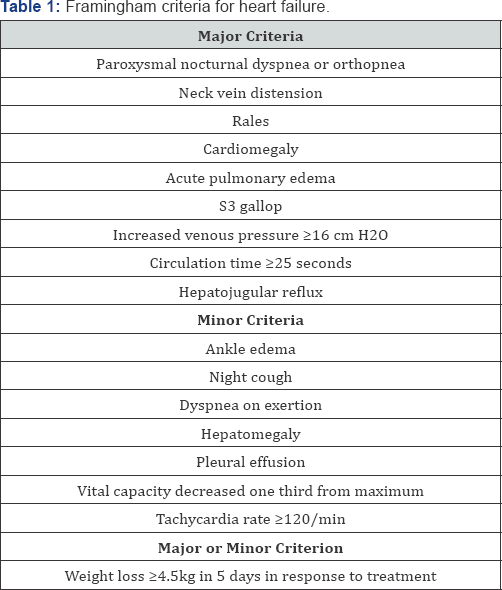
Nt-ProBNP analysis: 5-mL blood sample was immediately collected into a tube containing potassium ethylenediamine- tetraacetic acid (1mg/ml blood), centrifuged and stored at 80 °C. NT-proBNP analysis was per- formed with a commercially available immunoassay (Elecsys pro-BNP, Roche Diagnostics, Indianapolis, IN) on an Elecsys 1010 analyzer. The coefficient of variation for inter- and intraassay precision was <4%.
Echocardiographic data: Doppler echocardiograms were obtained at the bedside by cardiologists experienced in echocardiography. The left ventricular ejection fraction (LVEF) was estimated mainly by visual inspection. Diastolic indices included: the early (E) and late (A) diastolic filling velocities, the E/A ratio, and the early deceleration time (DT). Diastolic function was initially classified as:
1. Impaired relaxation: When E/A ratio < 1 with DT > 220 ms, suggesting no increase in LV filling pressures;
2. Restrictive: when the E/A ratio > 2 or E/A between 1 and 2 and DT< 150 ms, or DT < 150 ms alone in case of atrial fibrillation, suggesting an increase in LV filling pressures;
3. Normal or pseudonormal: when E/A between 1 and 2 and DT > 150 ms;
Outcome measures
A medical staff including cardiologist, pneumologist and intensivist, who were blinded to the results of Nt-ProBNP assay and Doppler echocardiography obtained on admission, established the etiology of dyspnea. They had access to ED records, clinical notes, and any additional information that became available during hospital stay. The Confirmation of CHF was based on the Framingham criteria, response to treatments (diuretics, vasodilators, inotropic agents), hemodynamic monitoring and pulmonary functional tests. Patients were finally classified as CHF or non-CHF.
Statistical analysis
Categorical data are presented as numbers (percent), and continuous data as means SD. The Students t test and the Fisher exact test were used as indicated. Group comparisons of Nt-ProBNP values were made using analysis of variance (ANOVA) with the Newman- Keuls post hoc test; p values 0.05 were considered significant. The sensitivity, specificity, accuracy, negative and positive predictive values of Nt-ProBNP assay and Doppler echocardiography for CHF were compared. We also computed receiver operating characteristic (ROC) curves to determine optimal Nt-ProBNP cutoffs. We calculated the diagnostic performance of the Framingham criteria, of Nt-proBNP, of the LVEF and of the diastolic dysfunction. The analyses were performed using SPSS 20 software.
Results
Characteristics of study patients
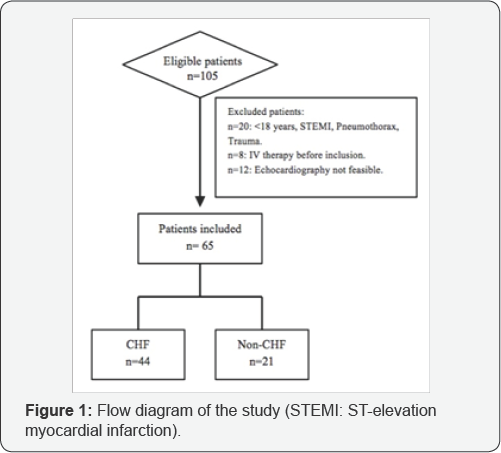
A total of 105 patients were eligible for the study, of whom 40 met exclusion criteria Figure 1. A total of 65 patients were enrolled in the study. The clinical and demographic characteristics of patients are presented in Table 2, according to the final diagnosis. Among these patients, 39 (60%) had severity signs and were admitted to the intensive care unit, mechanical ventilation was indicated in 10% of these (n=4). Of the remaining 26, 20 (30%) were admitted to a general medical ward, and 6 (10%) were observed in the ED. During hospitalization 6 patients (9%) died.
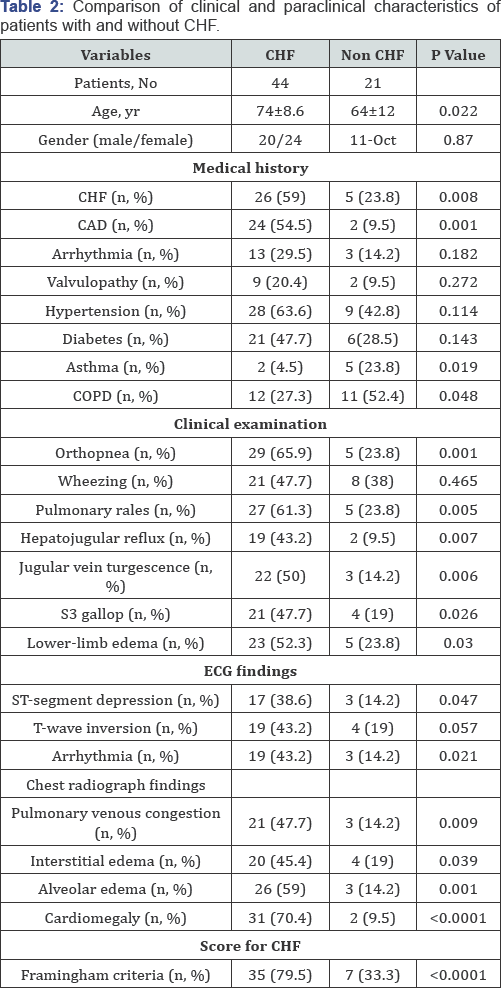
The mean time between the onset of acute dyspnea and inclusion in the study was 6,2 ± 3,8 hours. The diagnosis of CHF was retained in 44 cases. CHF was due to coronary artery disease (n=20), hypertension (n=14), arrhythmia (n=8), and valve disease (n=2). Non-CHF, 21 cases, was due to pneumonia (n=9), decompensated chronic obstructive pulmonary disease (n=8), severe asthma (n=3) or pulmonary embolism (n=1). The patients with CHF were older than those with dyspnea from other causes (74 years versus 64 years, p<0.05). They had more history of cardiovascular diseases such as chronic heart failure (p=0.008) and coronary artery diseases (CAD) (p=0.001). The patients with no-CHF were more likely to have a history of respiratory diseases such as asthma (p=0.019) and COPD (p=0.048). On clinical examination, patients with CHF had more symptoms (orthopnea), pulmonary rales, Hepatojugular reflux, jugular vein turgescence, third heart sound and lower- limb edema. They also had a higher incidence of abnormal ECG findings (ST-segment depression, Arrhythmia), cardiomegaly and interstitial or alveolar edema. The proportion of patients satisfying the Framingham criteria for CHF was significantly higher in patients with CHF (79.5% versus 33.3%, p<0.0001). The initial diagnosis was wrong in 15 patients (23%): CHF was missed in 10 (15.38%) patients and wrongly diagnosed in 5(7.69%) patients.
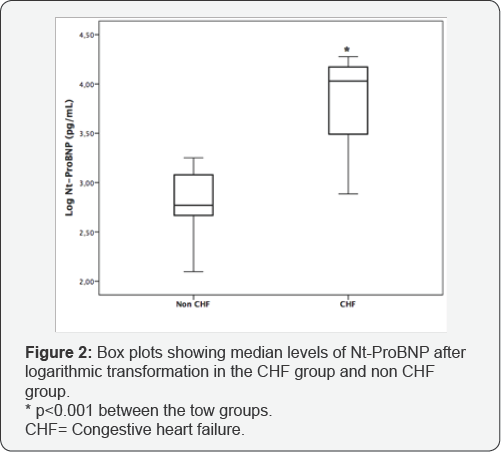
Nt-ProBNP and echocardiographic findings: The Nt-ProBNP measurement and Doppler-Echocardiographic findings were resumed on Table 3. The mean Nt-ProBNP concentration was 9188±6338pg/mL in the CHF group, compared with 416±400pg/mL in the non-CHF group (p<0.0001). Figure 2 shows box plots of log Nt-ProBNP values in each final diagnostic group. Left ventricular EF was significantly lower in patients with CHF (40.93±12.2 versus 55.29±7.8, p<0.0001). Systolic left ventricular dysfunction (EF<0.45) was found in 29 (65.9%) patients with CHF and in 4 (19%) patients with other causes of dyspnea (p<0.0001). The log Nt-ProBNP values for each quartile of EF are presented in Figure 3A for patients with CHF and in Figure 3B for patients without CHF. Nt-ProBNP concentrations were significantly higher in patients with abnormal systolic function in the two groups; and they increased with the decrease in EF. The E/A ratio and DT were significantly lower in patients with CHF, (1.24±0.72 versus 1,68±0.46, p=0.001) and (149.4±58 versus 209±40.5, p=0.03) respectively. Diastolic dysfunction was more pronounced in patients with CHF, "impaired relaxation" and "restrictive pattern" was found respectively in 17 (38.6%) and 24 (54.5%) of the patients with CHF and in only 2 (14.2%) and 3 (19%) of the patients with other etiologic diagnoses. Patients with abnormal diastolic function (n=18) had a concentration of 2250±1980pg/mL, whereas the normal subjects (n=16) had a mean Nt-ProBNP concentration of 596±345pg/mL (p<0.0001). Figure 4 shows box plots of log Nt-ProBNP values in each subgroups of diastolic dysfunction. Patients with "restrictive Pattern" had significantly higher Nt-ProBNP levels than patients with "impaired relaxation" (10323±6072pg/mL versus 5807±6140 pg/mL, p<0.001). The mean Nt-ProBNP concentrations was significantly higher in patients with systolic dysfunction than in those with diastolic dysfunction, and highest in those with both systolic and diastolic dysfunction, as it shown in Figure 5.
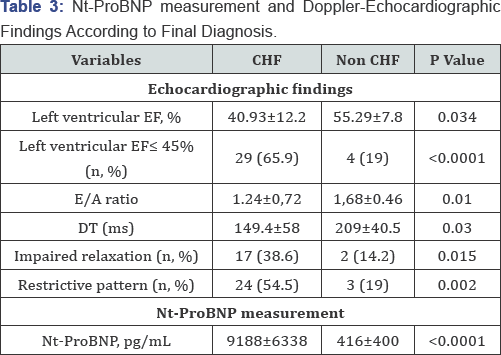
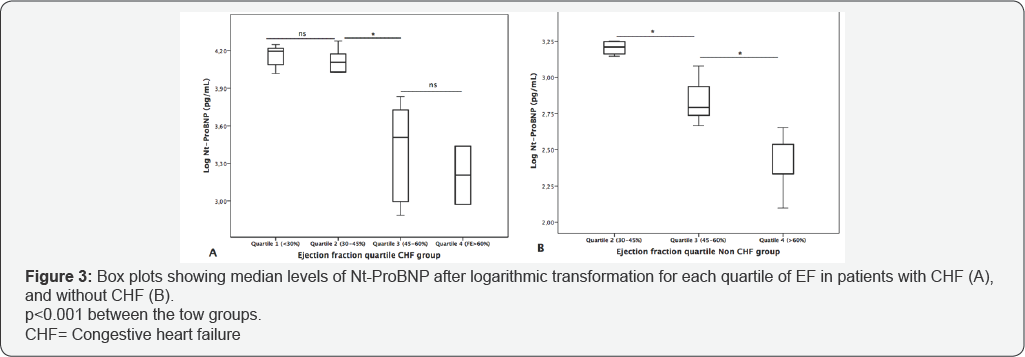
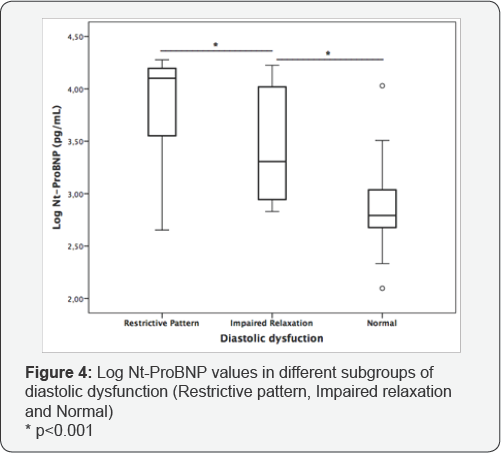

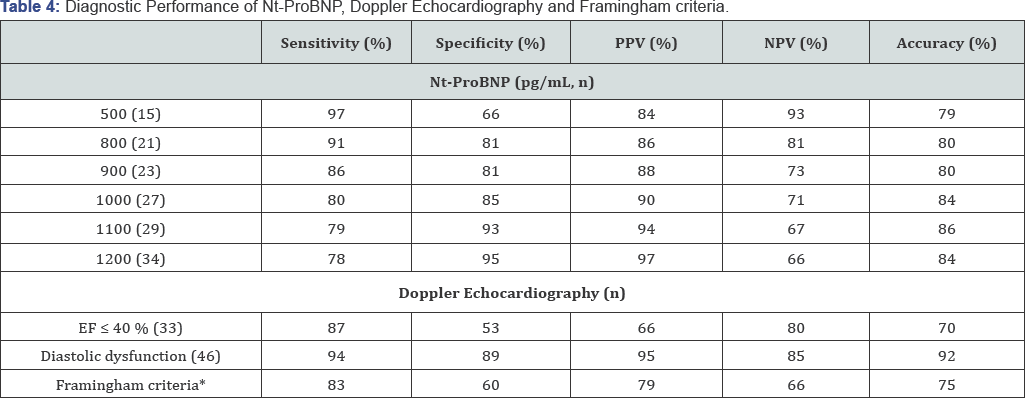
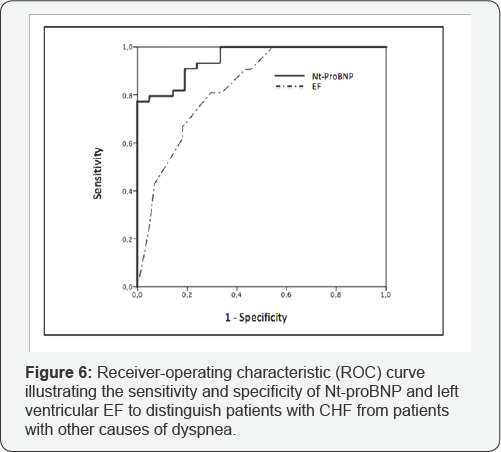
Etiologic diagnosis performance of nt-probnp and echocardiography: Both, Nt-ProBNP and left ventricular EF were used to differentiate CHF from other causes of dyspnea; the area under the ROC curve was significantly higher for Nt- ProBNP than for EF (0.95 versus 0.83, p<0.0001) Figure 6. The diagnosis performance of Nt-ProBNP, left ventricular EF, diastolic dysfunction and Framingham criteria was summarized in Table 4. The Nt-ProBNP cutoff value of 500pg/mL had the highest sensitivity (97%) and negative predictive value (93%) but a specificity of (66%). The cutoff value of 1100 pg/mL had the highest specificity (93%) and accuracy (86%) but a sensibility of (79%). Left ventricular EF had the lowest positive predictive value (66%) and accuracy (70%). The best diagnostic performance was found with the presence of ("impaired relaxation" and "restrictive pattern") with an accuracy of 92%. Between 500 and 1100pg/mL, Nt-ProBNP had a poor predictive value of the final diagnosis of CHF (OR 1.16, 95% CI [0.7 to 1.8], p=0.43). Fifteen (23%) patients belonged to this interval, among them 10 patients were misdiagnosed at admission. Nt-ProBNP cutoff values of 600, 800 and 1000pg/mL correctly identified 7, 5 and 2 patients respectively. The presence of diastolic dysfunction on Doppler analysis of mitral inflow correctly classified 13 of these patients and correct 8 of the 10 clinical misdiagnoses Figure 7.
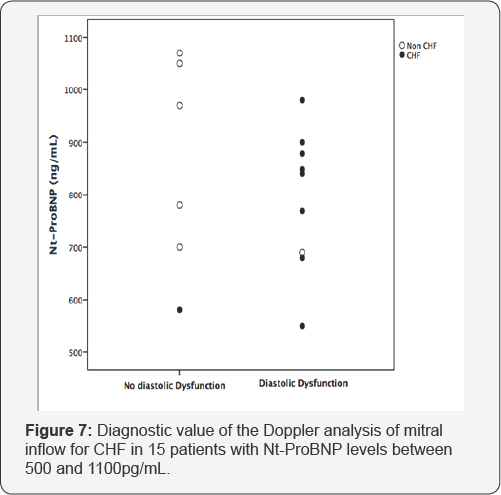
Discussion
The etiologic diagnosis of acute dyspnea in the ED is difficult because of the non-specificity of the symptoms and non-sensitivity of physical, electrocardiogram and chest x-rays findings, which constitute a source of misdiagnosis [2]. In our study, 23% of patients consulting for acute dyspnea were misdiagnosed; this rate is close to that found in some studies [17,18]. According to the latest guidelines, natriuretic peptides and Doppler Echocardiography are now considered to be part of the standard workup of patients presenting with acute dyspnea to the ED [10,12]. Our results show that Nt ProBNP and Doppler Echocardiography have an important contribution to the etiologic diagnosis of acute dyspnea in the ED. Many studies have validated the high diagnostic accuracy of Nt-ProBNP in the ED [19,20]. The 2012 European Society of Cardiology guidelines for heart failure endorsed specific age independent decision cutoffs for plasma Nt-ProBNP <300pg/mL, for the exclusion of acute heart failure based on consensus of expert opinion [12]. The PRIDE (N-Terminal Pro- BNP Investigation of Dyspnea in the Emergency Department) study demonstrated that Nt-ProBNP level ≤300pg/ml was optimal for ruling out acute CHF [20]. Other studies demonstrated equal value of NT-proBNP [21]. In our study, we found that Nt-ProBNP cutoff of 500pg/mL had a high negative predictive value (93%) with acceptable sensitivity and specificity. This difference in cutoff values of Nt-ProBNP was mainly due differences in study populations. A major part of our population had a high mean age with comorbidities such us renal failure and was admitted to the intensive care unit for severe dyspnea, in contrast to the other studies [20,21]. In the other hand, a strong positive predictive value (94%), and a highest accuracy (86%) were obtained with a cutoff of 1100pg/ mL. The diagnostic value of the Nt-ProBNP was poor at values between 500 and 1100 pg/mL (23% of our patients). 40% of these patients had a final diagnosis of Non-CHF due to severe pneumonia, decompensated chronic obstructive pulmonary disease, or pulmonary embolism. Indeed, several pathologies including infectious diseases, renal failure, critical illness, cirrhosis of liver, intracranial pathologies, may be the cause of high values of Nt-ProBNP even in the absence of depressed cardiac function [22].
Secondly, our work has demonstrated the superiority of Nt- ProBNP compared to the left ventricular ejection fraction (LVEF) in the etiologic diagnosis of acute dyspnea. The calculated area under the ROC curve was 0.95 for Nt-ProBNP, compared with 0.83 for LVEF. In addition, LVEF had a poor positive predictive value (66%) and accuracy (70%). Indeed, it is now accepted that a high proportion of patients with CHF have normal left ventricular systolic function and this was the case in 33% of our patients [23]. That is why we can no longer rely solely on the LVFE for the diagnosis of CHF. Given that Nt-ProBNP is useful for the diagnosis of CHF both in patients with and without systolic dysfunction [24,25]. Combining tow-dimensional imaging and Doppler, provides more data then LVEF accurate in distinguishing between acute dyspnea due to CHF and forms due to other causes. Tissue Doppler has recently become a gold standard for diagnosing diastolic heart failure, but it requires expertise, and it is not often used or applicable in an emergency setting, especially in patients with dyspnea [24,26]. In our study, we are based on the measurement of the E/A ratio, and the early deceleration time (DT) to evaluate diastolic function. They are easy to have values in the emergency context and do not require significant expertise. Several studies have shown a correlation between the early (E) and late (A) diastolic filling velocities, the E/A ratio, the early deceleration time (DT), mitral inflow pattern with left ventricular end diastolic pressure, and pulmonary capillary wedge pressure at rest [15,17]. Nazerian et al. demonstrated that emergency Doppler echocardiography, particularly pulsed Doppler analysis of mitral inflow, is a rapid and accurate diagnostic tool in the evaluation of patients with acute dyspnea [15]. In our study, the presence of echocardiographic signs of diastolic dysfunction (impaired relaxation, normal or normalized pattern and restrictive pattern) showed a better sensitivity (94%), specificity (89%), positive predictive value (95%), negative predictive value (85%) and accuracy (92%) for the diagnosis of CHF compared with reduced LVEF and Framingham criteria. In addition, the importance of echocardiography findings is especially confirmed in the gray area of the Nt-ProBNP values largely limiting its clinical usefulness [15,17,27]. In this study, the presence of diastolic dysfunction on Doppler analysis of mitral inflow correctly classified 87% of patients belonging to that area and corrects 80% of clinical misdiagnoses.
Thirdly, Our study has revealed that Nt-ProBNP concentrations vary according to the type of heart failure. In fact, several studies have shown that the mean Nt-ProBNP concentrations was significantly higher in patients with systolic dysfunction than in those with diastolic dysfunction, and highest in those with both systolic and diastolic dysfunction [28,29]. On the other hand, we have shown that Nt-ProBNP concentrations were different in subgroups of diastolic dysfunction but all subgroups had higher Nt-ProBNP levels than patients with no-CHF. We can conclude that Nt-ProBNP concentrations increase according to the stage of diastolic dysfunction. In the first stage of diastolic dysfunction (impaired relaxation), Nt-ProBNP levels mildly increase; in a second stage (pseudonormalized filling pattern) these levels moderately increase; and in an advanced stage of diastolic 11dysfunction (restrictive filling pattern) Nt-ProBNP concentrations are markedly increased and our study supports these findings [30,31]. Therefore, Nt-ProBNP measurements can play a crucial role in the diagnosis of diastolic dysfunction. Tschope, et al. [32] concluded that Nt-proBNP reliably detects diastolic dysfunction in patients with filling abnormalities and preserved LV systolic function. The consensus statement on the diagnosis of heart failure with normal left ventricular ejection fraction by the Heart Failure and Echocardiography Associations of the European Society incorporated the Nt-ProBNP in to the algorithm for the diagnosis of heart failure [26]. The optimal cutoff value for a diastolic dysfunction diagnosis is still unclear and we need further investigation with echocardiography to verify the diagnosis of abnormal cardiac function.
Conclusion
Nt ProBNP and Doppler Echocardiography have an important contribution to the etiologic diagnosis of acute dyspnea in the ED. In the present study, the major contribution of the Nt-ProBNP is the ability to rule out the diagnosis of CHF in the ED with a cutoff of 500pg/mL, whereas above this value and especially in the gray area, it is only a fair indicator of the disease. Thereby, Doppler echocardiography represent the « gold standard » in the evaluation of patients with acute dyspnea by the ability to evaluate diastolic and systolic function on one hand and to clarify the etiological diagnosis on the other hand. Certainly, Nt- ProBNP measurements can play a crucial role in the diagnosis of diastolic dysfunction but its interpretation should consider the echocardiography findings.
References
- Roger VL, Go AS, Lloyd-Jones DM, Benjamin EJ, Berry JD, et al. (2012) Heart disease and stroke statistics--2012 update: a report from the American Heart Association. Circulation 125(1): e2-e220.
- Storrow AB, Jenkins CA, Self WH, Alexander PT, Barrett TW, et al. (2014) The burden of acute heart failure on U.S. emergency departments. JACC Heart Fail 2(3): 269-277.
- Rutten FH, Moons KG, Cramer MJ, Grobbee DE, Zuithoff NP, et al.(2005) Recognising heart failure in elderly patients with stable chronic obstructive pulmonary disease in primary care: cross sectional diagnostic study. BMJ 331(7529): 1379.
- Daniels LB, Clopton P, Bhalla V, Krishnaswamy P, Nowak RM, et al.(2006) How obesity affects the cut-points for B-type natriuretic peptide in the diagnosis of acute heart failure. Results from the Breathing Not Properly Multinational Study. Am Heart J 151(5): 999-1005.
- Hawkins NM, Petrie MC, Jhund PS, Chalmers GW, Dunn FG, et al. (2009) Heart failure and chronic obstructive pulmonary disease: diagnostic pitfalls and epidemiology. European journal of heart failure 11(2): 130-139.
- Al Deeb M, Barbic S, Featherstone R, Dankoff J, Barbic D (2014) Point-of- care ultrasonography for the diagnosis of acute cardiogenic pulmonary edema in patients presenting with acute dyspnea: a systematic review and meta-analysis. Acad Emerg Med 21(8): 843-852.
- Maisel AS, Krishnaswamy P, Nowak RM, McCord J, Hollander JE, et al. (2002) Rapid measurement of B-type natriuretic peptide in the emergency diagnosis of heart failure. N Engl J Med 347: 161-167.
- Salpeter SR, Ormiston TM, Salpeter EE (2004) Cardiovascular effects of P-agonists in patients with asthma and COPD: a meta-analysis. CHEST Journal 125(6): 2309-2321.
- Palazzuoli A, Beltrami M, Ruocco G, Pellegrini M, Nuti R (2013) The role of natriuretic peptides for the diagnosis of left ventricular dysfunction. ScientificWorldJournal 2013: 784670.
- Yancy CW, Jessup M, Bozkurt B, Butler J, Casey DE, et al. (2013) 2013 ACCF/AHA guideline for the management of heart failure: a report of the American College of Cardiology Foundation/American Heart Association Task Force on Practice Guidelines. J Am Coll Cardiol 62(16): e147-e239.
- Roberts E, Ludman AJ, Dworzynski K, Al-Mohammad A, Cowie MR, et al. (2015) The diagnostic accuracy of the natriuretic peptides in heart failure: systematic review and diagnostic meta-analysis in the acute care setting. BMJ 350: h910.
- McMurray JJ, Adamopoulos S, Anker SD, Auricchio A, Bohm M, et al. (2012) ESC Guidelines for the diagnosis and treatment of acute and chronic heart failure 2012. European journal of heart failure 14: 803869.
- Maries L, Manitiu I (2013) Diagnostic and prognostic values of B-type natriuretic peptides (BNP) and N-terminal fragment brain natriuretic peptides (NT-pro-BNP). Cardiovasc J Afr 24(7): 286-289.
- Palazzuoli A, Gallotta M, Quatrini I, Nuti R (2010) Natriuretic peptides (BNP and NT-proBNP): measurement and relevance in heart failure. Vascular health and risk management 6: 411-418.
- Nazerian P, Vanni S, Zanobetti M, Polidori G, Pepe G, et al. (2010) Diagnostic accuracy of emergency Doppler echocardiography for identification of acute left ventricular heart failure in patients with acute dyspnea: comparison with Boston criteria and N-terminal prohormone brain natriuretic peptide. Acad Emerg Med 17(1): 18-26.
- Ho KK, Anderson KM, Kannel WB, Grossman W, Levy D (1993) Survival after the onset of congestive heart failure in Framingham Heart Study subjects. Circulation 88(1): 107-115.
- Logeart D, Saudubray C, Beyne P, Thabut G, Ennezat PV, et al. (2002) Chavelas C, Zanker C, Bouvier E, Solal AC. Comparative value of Doppler echocardiography and B-type natriuretic peptide assay in the etiologic diagnosis of acute dyspnea. Journal of the American College of Cardiology 40(10): 1794-1800.
- /a> Dao Q, Krishnaswamy P, Kazanegra R, Harrison A, Amirnovin R, et al. (2001) Utility of B-Type Natriuretic Peptide in the Diagnosis of Congestive Heart Failure in an Urgent-Care Setting. J Am Coll Cardiol 37(2): 379-385.
- Troughton RW, Frampton CM, Brunner-La Rocca HP, Pfisterer M, Eurlings LW, et al. (2014) Effect of B-type natriuretic peptide-guided treatment of chronic heart failure on total mortality and hospitalization: an individual patient meta-analysis. Eur Heart J 35(23): 1559-1567.
- Januzzi JL, Camargo CA, Anwaruddin S, Baggish AL, Chen AA, et al. (2005) The N-terminal Pro-BNP investigation of dyspnea in the emergency department (PRIDE) study. Am J Cardiol 95(8): 948-954.
- Shaikh K, Ahmad M (2011) Diagnostic significance of NT-proBNP estimation in patients with acute dyspnea. J Coll Physicians Surg Pak 21(10): 584-588.
- Tsai SH, Lin YY, Chu SJ, Hsu CW, Cheng SM (2010) Interpretation and use of natriuretic peptides in non-congestive heart failure settings. Yonsei Med J 51(2): 151-163.
- Vasan RS, Larson MG, Benjamin EJ, Evans JC, Reiss CK, et al. (1999) Congestive heart failure in subjects with normal versus reduced left ventricular ejection fraction: prevalence and mortality in a population- based cohort. Journal of the American College of Cardiology 33(7):1948-1955.
- Steg PG, Joubin L, McCord J, Abraham WT, Hollander JE, et al. (2005) B-type natriuretic peptide and echocardiographic determination of ejection fraction in the diagnosis of congestive heart failure in patients with acute dyspnea. Chest 128(1): 21-29.
- Maisel AS, McCord J, Nowak RM, Hollander JE, Wu AHB, et al. (2003) Bedside B-Type natriuretic peptide in the emergency diagnosis of heart failure with reduced or preserved ejection fractionResults from the Breathing Not Properly Multinational Study. J Am Coll Cardiol 41(11): 2010-2017.
- Paulus WJ, Tschope C, Sanderson JE, Rusconi C, Flachskampf FA, et al.(2007) How o diagnose diastolic heart failure: a consensus statement on the diagnosis of heart failure with normal left ventricular ejection fraction by the Heart Failure and Echocardiography Associations of the European Society of Cardiology. Eur Heart J 28(20): 2539-2550.
- Berdague P, Caffin PY, Barazer I, Vergnes C, Sedighian S, et al. (2006) Use of N-terminal prohormone brain natriuretic peptide assay for etiologic diagnosis of acute dyspnea in elderly patients. American heart journal 151(13): 690-698.
- Wei T, Zeng C, Chen L, Chen Q, Zhao R, et al. (2005) Systolic and diastolic heart failure are associated with different plasma levels of B-type natriuretic peptide. Int J Clin Pract 59(8): 891-894.
- Maisel AS, Koon J, Krishnaswamy P, Kazenegra R, Clopton P, et al. (2001) Utility of B-natriuretic peptide as a rapid, point-of-care test for screening patients undergoing echocardiography to determine left ventricular dysfunction. Am Heart J 141(3): 367-374.
- Lubien E, DeMaria A, Krishnaswamy P, Clopton P, Koon J, et al. (2002) Utility of B-natriuretic peptide in detecting diastolic dysfunction: comparison with Doppler velocity recordings. Circulation 105(5): 595-601.
- Yu CM, Sanderson JE, Shum IO, Chan S, Yeung LY, et al. (1996) Diastolic dysfunction and natriuretic peptides in systolic heart failure. Higher ANP and BNP levels are associated with the restrictive filling pattern. Eur Heart J 17(11): 1694-1702.
- Tschöpe C, Kašner M, Westermann D, Gaub R, Poller WC, et al. (2005) The role of NT-proBNP in the diagnostics of isolated diastolic dysfunction: correlation with echocardiographic and invasive measurements. European heart journal 26(21): 2277-2284.






























